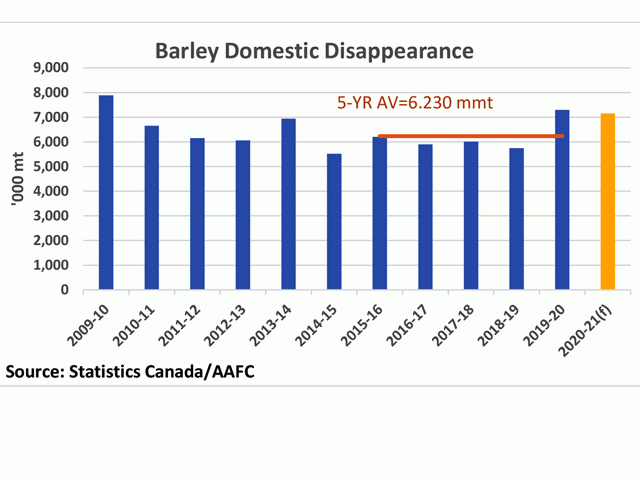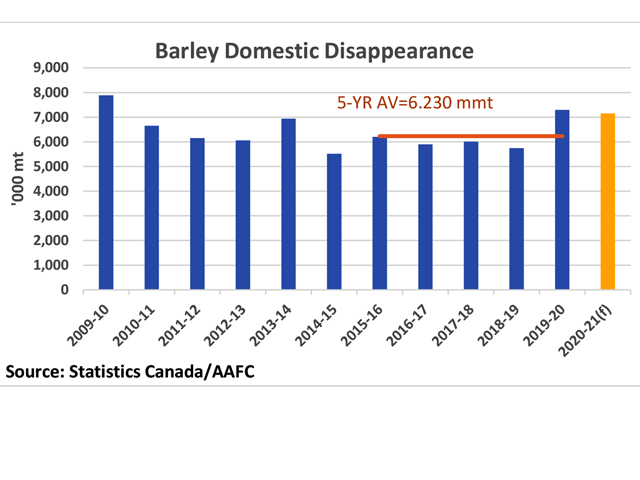Canada Markets
Supportive Signals Seen for Feed Barley
On Oct. 6, an Alberta broker reported a sizeable quantity of barley sold into southern Alberta for Jan.-Feb. delivery at $260/metric ton, with signs of Nov/Dec trade at $245/mt. This price level signals a sharp recovery from the low $200 range reached in August and well-above spot trade from $235/mt to $245/mt seen over the past week.
This compares to the 2019-20 crop year with Alberta Agriculture's weekly average shown at $269/mt in early August 2019, only to trade lower for the balance of the crop year, with Agriculture and Agri-Food Canada reporting an average price for 2019-20 at $232/mt delivered to Lethbridge.
Here are factors to consider that I believe will prove supportive for this market over the crop year.
Government struggled to estimate feed demand for the 2019-20 crop year. In late August, AAFC's supply and demand tables had pegged domestic disappearance of barley for the crop year at 6.895 million metric tons, with ending stocks estimated at 1.4 mmt, a 62% increase year-over-year. Statistics Canada's ending stocks estimate of 957,000 metric tons as of July 31 was well below this forecast, forcing AAFC to revise higher domestic use forecast to 7.336 mmt, 441,000 mt higher, which would represent the largest use in 10 years and well-above the five-year average of 6.230 mmt. The current forecast for 2020-21 is slightly lower at 7.151 mmt, which bears watching.
P[L1] D[0x0] M[300x250] OOP[F] ADUNIT[] T[]
As recently as January 2020, ending stocks for 2019-20 were estimated by the government at 1.8 mmt, almost double the official estimate as of July 31. The current forecast for 2020-21 ending stocks is for a slight increase to 1.1 mmt, which is still below the five-year average of 1.4 mmt, supportive for prices.
The pace of exports must be considered. The current forecast released by AAFC for 2020-21 is for 3 mmt of exports (including products), unchanged from the previous crop year. At the same time, the Canadian Grain Commission's Grain Statistics Weekly for week 8 shows barley exports at 409,600 mt, a pace that is 160% higher than the same week in 2019-20 and 266% higher than the five-year average for this period.
Another factor that may affect the overall supplies of feed grains is the early harvest and relatively good weather leading to high grades. The CGC's first wheat harvest data shows that of 1,150 samples of CWRS graded as of Sept. 28, 95.5% is grading No. 1 CWRS or No. 2 CWRS. Of 422 samples of durum graded, 86.3% are graded in the top two grades.
AgCanada.com reports this week that cattle on feed in Alberta and Saskatchewan are close to 20% higher than the five-year average, with an ongoing backlog of fat cattle due to this summer's packing plant closures and pen space in demand. As well, USDA data shows that Canada's exports of fed cattle and cows for the week-ending Sept. 19 is up from the previous week and still 9.2% lower than the same week in 2019.
Lastly, the current La Nina event is to lead to a colder-than-normal winter on the Prairies. Grain movement may slow as a result over the months ahead and be harder to access, supportive for prices.
Watch for barley to continue to strengthen.
Cliff Jamieson can be reached at cliff.jamieson@dtn.com
Follow him on Twitter @Cliff Jamieson
© (c) Copyright 2020 DTN, LLC. All rights reserved.






Comments
To comment, please Log In or Join our Community .